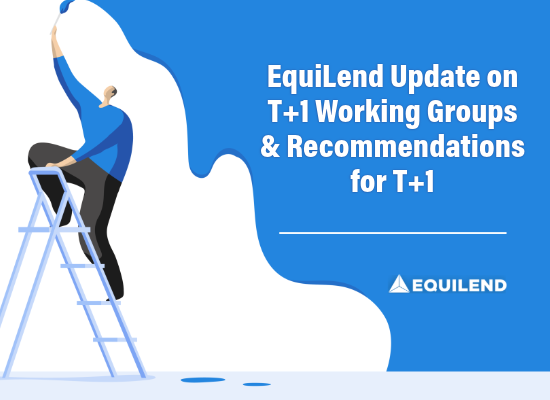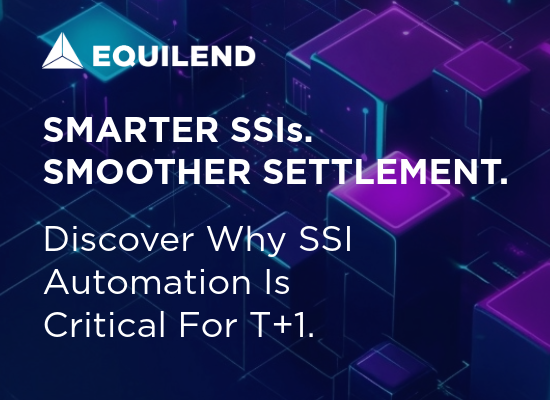Insight
May 2024
CJ Emson
T+1 Unlocked: Navigating the Shift to Expedited Settlement
In the ever-evolving landscape of securities finance, the introduction of T+1 settlement has proven to be a flash point for the industry. With T+1 imminent in Canada, the United States, Argentina and Mexico and the Accelerated Settlement Taskforce (AST) report advocating for the transition to T+1 trading in EMEA by the end of 2027, T+1 is proving to be a sweeping contagion of desirable change. The financial industry now faces the challenge of navigating towards the successful implementation of T+1, through myriad institutional challenges.
The push towards T+1 settlement signifies a fundamental shift in the operational dynamics of trading. Unlike broader regulatory reforms post-2008, which focused on capital requirements and risk frameworks, the move to T+1 has a direct, day-to-day impact on trading activities themselves. It necessitates a re-evaluation of existing infrastructures and processes to accommodate the shortened settlement cycle, effectively. The need for global coordination and future-proofed tech led solutions are increasingly important to navigate these complexities successfully.
EMEA Challenges to T+1
For North America, T+1 settlement presents a neat opportunity to clean house and streamline a number of processes to gain efficiencies which will translate to and support timely settlement across the trade lifecycle. The relative youth of the U.S. as a market makes much of this transition fairly straightforward with greater unification of jurisdictions, fewer trading venues and one central clearing house. Canada and Mexico’s markets are similarly straight forward by comparison to EMEA, with Mexico’s exception of 2 clearing venues. Removing the business day between trade and settlement is problematic as a concept but not insurmountable for North America with a simpler market make up, although there are also multiple time zones to account for in the territory.
The problems for Europe in approaching T+1 settlement include the use of multiple trading venues across multiple jurisdictions, complicated further by multiple counterparties across those jurisdictions as well as multiple collateral types and schedules to contend with. Consider also that additionally EMEA utilizes multiple CSDs and has multiple time-zones from GMT to GMT+2 scoped within this one territory.
The challenge is not only in time zone conflicts; the disparity in settlement cycles between regions and a reliance on batch processing over real-time data exchange, introduces additional complexities for market participants engaged in cross-border trading. Real-time market data availability combined with automated trading and post trade tools can help smooth the jarring co-existence of different settlement timelines between North America and Europe. The added complexity of EMEA’s multiple market infrastructures, collateral complexities, legal frameworks and central cross border interactions should not be underestimated.
Any efficiencies gained in the adoption of T+1 will require vendor support to ensure timely exchange of accurate, real-time trading data, allowing for operations teams to focus on processing any remaining errors in a compressed timeline.
Settlement Challenges
Ahead of the impending shift in the U.S., Canada, Argentina and Mexico to T+1 in May 2024, financial institutions are bracing for a higher rate of failed trades, underscoring the critical importance of thorough preparation and adopting robust risk management frameworks in other territories to mitigate settlement risks.
The EMEA Accelerated Settlement Working Groups identified 6 common issues that threaten settlement in EMEA: data quality, inventory problems, inefficiencies caused by counterparty behavior, workflow management, market standards and regulation and market infrastructure limitations. The primary concern stemming from these combined issues is the potential increase in settlement failures with the proposed introduction of T+1 settlement to EMEA. This echoes the apprehension and disruption seen in markets with the advent of CSDR where an increase in so called ’ghost trades’ was observed as market participants sought to cover pending trades with double borrowing, increasing returns volumes and reducing inventory availability.
Before T+1, EquiLend already supported the automation of trades, identification and mitigation of settlement risk and assured accurate, timely collateral transfer within our existing suite of solutions. EquiLend’s T+1 solution unifies multiple interconnected solutions with NGT for automated trade execution and additional real-time data market view with Competitive Bid. Post-Trade has seen streamlining with Risk Resolution Suite (R2S) which combines EquiLend’s Recalls, Returns and Settlement Monitor solutions within a single UI, enabling users to gain efficiency in identifying settlement threats and automating, executing and agreeing recalls and returns. Exposure Management facilitates friction free collateral agreements and mobilizes collateral cover while 1Source ensures a future-proofed solution using DLT to record a central source of truth across the trade lifecycle, eliminating reconciliation and the downstream breaks which come with it. A suite of solutions designed to maintain T+1 compliance which are already core parts of our existing ecosystem.
Operations Challenges
Key to the successful execution of T+1 will be the teams executing on the shorter settlement cycle and ensuring they are given the tools to navigate the challenges posed by accelerated settlement cycles. Arguably, the biggest issues will be faced by what are traditionally back-office operations teams tasked with ensuring minimal disruption downstream. With T+1, there is an increasing need for timely settlement processes to emerge from the back office and become a shared concern across every department. Workflow hand-off and communication tools across the front, middle and back office, are needed to solve for T+1, in addition to adaptable, interconnected solutions. Realizing T+1 requires ready access to real-time data and fully automated, interoperable processes; a USP of EquiLend’s ecosystem of solutions. Automation tools are the single strongest addition to a firm’s tech stack to best support day one execution of T+1 settlement.
Automation already powers many corners of the industry. With the majority of the securities finance market on NGT, we evidenced that average daily notional traded on EquiLend NGT increased by more than a third between 2015 and the launch of CSDR in 2022. Year on year, from 2022-2023, we saw a 10% increase in automated trading alone. As regulation and the years have progressed, we have seen further uptake in our automated solutions. Gabi Mantle, EquiLend’s Head of Post-Trade Solutions, and committee member of the multiple Accelerated Settlement committees including the UK Accelerated Settlement Taskforce Technical Group, shared that “the majority of clients using NGT, also use one or more automated solutions from EquiLend.”
The success of the transition to T+1 in EMEA hinges on this multifaceted approach combining regulatory alignment, technological innovation and industry collaboration in response to the many barriers that must be overcome. Talk to us about these options to support T+1 for your firm.
You may also like:
EquiLend Client Forum 2025: 5 Roadmap Takeaways You Need to Know
We invited clients to share their thoughts on key industry questions as...
Read MoreEquiLend Update on the UK and European T+1 Reports and Recommendations
As a tech vendor servicing the securities finance sector with T+1 solutions,...
Read MoreThe Importance of Automating SSIs in a T+1 Environment
Enhancing efficiency in Securities Finance starts with automation to enable accuracy at...
Read More



